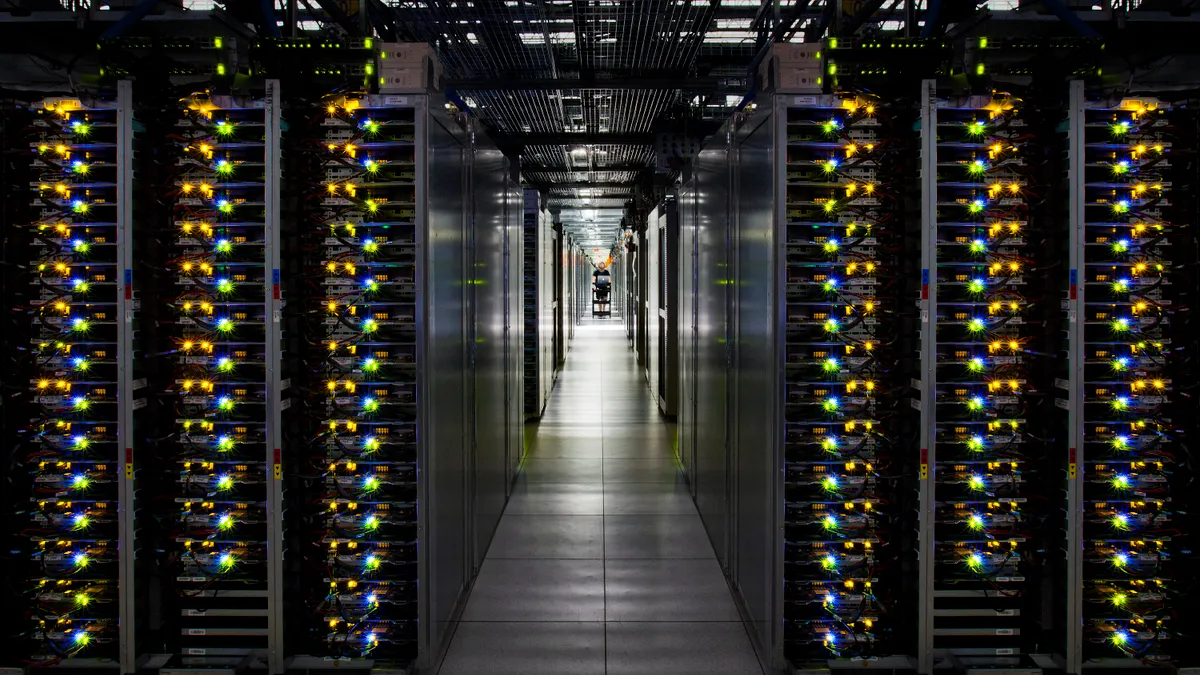Dive Brief:
- A new survey from the Uptime Institute concludes progress on data center energy efficiency has stalled — or is even losing ground — following rapid improvements in the last five to six years.
- The data centers, which power the internet, consume about 2% of the world's electricity today and experts say that figure could rise to 8% by 2030. Aside from computing power, much of the energy goes into keeping the centers cool and highlights the need for energy efficiency to reduce demand.
- Data center efficiency is measured through a power usage effectiveness (PUE) metric that compares electricity for computing power with cooling and other facility needs. A PUE of 1 would indicate all energy consumed by a data center goes to computing power, while a 2 would indicate equal amounts of energy are consumed for computing and ancillary uses.
Dive Insight:
Uptime Institute's 2019 survey found data centers averaged a PUE of 1.67, versus a PUE of 1.8 in 2011, meaning more of the energy that data centers consume is used for computing processes. That's a significant improvement, but the industry may be losing ground.
The rise of cloud computing is putting downward pressure on data center PUE as fewer computers are now doing the actual work, according to the Uptime Institute, an advisory group focused on business infrastructure. This follows years of improvement.
"Improvements in data center facility energy efficiency have flattened out and even deteriorated slightly in the past two years," according to the firm's annual survey, conducted online in March and April with 1,600 respondents.
Larger and more efficient data centers that power the cloud are doing more of the work now, with efficiency improvements slowing at smaller centers as the computing migrates.
"It's not overall efficiency that is stalled out — it's infrastructure efficiency," Matt Stansberry, the institute's vice president for North American operations, told Utility Dive. "For a long time, data centers were highly inefficient so, for every unit of energy used to run IT equipment doing productive work, there was a giant amount of overhead."
The PUE ratio "went down over the last 10 years as people started paying attention and making improvements," Stansberry said. Primarily, those improvements were to cooling systems. But with the rise of cloud computing, companies are using fewer computers and instead are relying on cloud-based systems.
"But [data center] buildings don't shift in real-time" to adjust the infrastructure supporting those computers, Stansberry said.
As more computing is done via the cloud, fewer computers mean these data centers may be over-built and less efficient. For utilities, they likely wont see significant load changes in the near term, though older data centers could close and growth in new additions could slow.
Further improvements to data center efficiency "will require significant investment and effort, with increasingly diminishing returns," Uptime Institute concluded. "While managers and operators should remain vigilant and seek to maintain high facility efficiency levels, higher gains may be found by focusing on IT efficiency."
That doesn't mean there isn't room for more traditional efficiency, Jim Kozlowski, vice president of global capacity planning and data center operations at Ensono, an IT services provider.
"Utilities help drive data center efficiency," Kozlowski told Utility Dive in an email. "By driving incentives or better economics, data center users will install more energy efficient infrastructure in the long term."
Many companies are in the process of modernizing their data centers, Kozlowski said. "So as they upgrade equipment and building management systems to meet certain standards, energy efficiency is improving."
The federal government has been keeping an eye on the sector as well. In 2016, the U.S. Department of Energy's Advanced Research Projects Agency-Energy offered $25 million for projects and technologies focused on increasing the energy efficiency of data centers.















